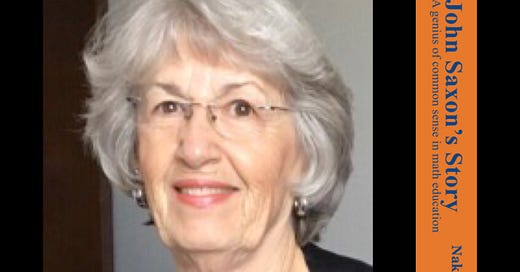Chapter 13: the reformist’s value system
“…the new approaches are unverified, but plausible.”
Prof. Alan Schoenfield, 1992
Not recognizing the distinction between John’s use of research to determine results for his program, compared to NCTM’s use of research to create their documents, those on John’s side of the issue would always come away dissatisfied as he kept pushing for data that would prove at least one NCTM-based curriculum was more effective than his. It was evidently an impossible task, simply because of the characteristics of the NCTM program, much of which was based on education philosophies from the early 1900’s. For the self-avowed reformers who wanted to bring social equity to classrooms, their “process” was the results—or the product of their work—at the expense of mathematics’ content. John’s challenges didn’t matter.
The NCTM group had built overwhelming connections to federal political power and tax dollars in the 1990’s. They would just keep repeating that John’s curriculum was “traditional”—which inflicted a derogatory value in the more progressive eyes of educators and political leaders.
One of their most illustrious spokespersons, Professor Alan Schoenfield, a mathematics educator at the University of California-Berkeley and an author of the 1992 California standards that reflected the NCTM standards, admitted, “[The] new programs lack ‘large-scale empirical proof of success or the existence of compelling and documentable standards.”1 To him, however, the alternative “standard curriculum,” or “drill and kill” techniques, didn’t work. He claimed the NCTM supporters had loads of information that traditional math “flops on its face for the vast majority of kids.” Consequently, “If you take a zero-base look, the new approaches are unverified, but plausible. The old approach is a proven failure.” Yet, their “supporting information” against was never forthcoming.
Arguing against those remarks was Wayne Bishop, a professor of mathematics at California State University-Los Angeles, who said, “There is no ‘system’ out there. When people talk about ‘traditional’ curricula, they are pretending as if we are following a plan that has been in place, when in fact we have been making serious compromises for years.”2
California officials also admitted the new approach was largely untested but said there was little they could do about it. In the past, they said, “Publishers had to show that their textbooks worked, but that system was suspended because data were often questionable or faulty.” Don Finerman, a recently retired state mathematics specialist in Oregon, agreed the method proposed by the NCTM council hadn’t been tested because that would have been too costly. It didn’t matter about the lack of testing according to Mr. Finerman, as he cited “the almost unanimous support of the new math strategy.”3 He explained standardized tests didn’t do a good job anyway of measuring the kind of higher-level thinking skills the new curriculum emphasized.
More national media attention was given to NCTM’s lack of proof in 1993 when Chester E. Finn, Jr., wrote an article entitled “What If Those Math Standards Are Wrong?” in Education Week.4 He said, “Seldom has so profound a change in conventional wisdom and standard practice had such homage paid to it, so little resistance shown to its onrush, so few doubts raised about its underpinnings…Gov. Roy Romer of Colorado and U.S. Secretary of Education Lamar Alexander praise the standards repeatedly…We better hope the NCTM has got it right. If not, American education’s lemming-like rush to follow its lead could find us hurtling off a precipice… What happens to millions of children who receive prepackaged programs and their teachers are ‘told’ the ‘approved’ way to proceed?
“So long as many teachers are dependent in this way, it’s vital to ask of any new approach being thrust upon the education world whether it has been fully tested with students to insure that it yields the desired results—and is not just being promoted because it appeals to grownups caught up in ideological battles.”
He quoted from a book by Siegfried Engelmann, a world authority on “direct instruction,” a highly structured approach with clear expectations for teachers and students with tight performance requirements and “behavioral” (rather “developmental”) instructional practices, along with a strong emphasis on accountability for results.
In War Against the Schools’ Academic Child Abuse (Halcyon House, 1992), Prof. Engelmann said, “The [NCTM] Standardsde-emphasize anything teachers have failed to teach…The most serious problem with the Standards, however, is its arrogance. In the tradition of the sorting-machine, it assumes that it can derive a curricular reform through metaphysical masturbation of words, not through experimental evidence about what works and what doesn’t. The writers of the Standards did not first verify these activities, suggestions, and standards by first demonstrating that they worked and that they created kids who performed well in math. Instead, they made it up and then presented it as an authoritative document.”
Dr. Finn concluded, “If Prof. Engelmann is right, we may be buying a pig in a poke…A full decade after A Nation at Risk and there’s scant evidence that reform strategies are working.” Instead, he said people are responding by seeking to ease the push for results by going back to indices of input, effort, and intention found in the failed “new math.”
In a 1994 article written by well-known education columnist Jay Mathews at The Washington Post, Douglas Carnine, University of Oregon education professor and director of the National Center for Improving Tools of Educators (NCITE), said education reform ideas in the U.S. rarely reflect much direct classroom research. In fact, he said his center found that 76 percent of teachers in a recent survey believed school reforms had not benefited the students who needed help the most.5
Researchers acknowledge the split between their work and what classroom teachers do, wrote Mr. Mathews, but they consider the difference a healthy antidote for complacency. “My business is to do research and development on problems of math teaching,” said James Fey at University of Maryland. “That’s why I am in a research university, and I’m naturally going to be interested in doing things which I hope are on the cutting edge. Unless I’m out ahead of the schools, I’m not doing my job.”
Regardless of the lack of proof of performance, under the new 1992 California curriculum framework, publishers who wished to sell to the state’s schools had to meet the new NCTM-dominated and non-researched criteria. Half of the state’s districts adopted those new reform standards. The others stayed with previous standards. By publishers having to meet the new California standards, this meant many other states would be receiving textbooks built around that state’s program. California and Texas have been the two leading buyers of textbooks; therefore, publishers tend to create books and materials that are geared for them. That meant the guts of the books that went to other states would follow the curricular philosophy and directions of those two states.
Because there was no evidence that could support the implementation, let alone the effectiveness of their promoted curriculum, discussions about “research” had to focus on the NCTM resource materials they had used to write their published “guidelines.” These topics included conceptual learning, group discussions, lots of writing, frequent use of calculators and computers, and multiple ways of solving problems. They downplayed the use of traditional procedures and equations, and they emphasized “discovery learning” (constructivism) where students worked on their own to teach themselves while in a group setting. In essence, when they said their programs were “research-based,” they were technically correct, but it was spin because it was a hodge-podge of different ideas and invalidated research.
Obviously feeling the heat over this issue, the NCTM hired a university professor to write a 1999 report about the problem.6Dr. James Hiebert, a professor of education at the University of Delaware, wrote that his task was to try and address “the role that research can and should play in shaping standards.” Saying that debates about mathematics reform had reached fever pitch, Dr. Hiebert reported that the questions were fair but they did not have simple answers. “Standards in any field are rarely based solely on research, so the connection between research and standards is never straightforward.” Then he issued a caveat: “Research…does not shine brightly on all aspects of the NCTM Standards, so we cannot provide blanket statements.”
He explained the following factors that affected his task:
Standards are not determined by research. As with other fields, he said, standards are statements about priorities and goals. In education they are about what is most valued by the professionals in the field. “While research can inform the debate, the reverse is equally true—the selection of standards signals what research is most relevant. If the paper-and-pencil computation of square roots is omitted from the standards, for example, then research that shows one method of teaching written computation of square roots is more effective than another probably will be ignored.” He said, “If ability to invent procedures to solve new problems is emphasized in the standards, then the research on students’ creative problem-solving is of great interest.”
He concluded that debates about what research says will not settle the issues. “Only debates about values and priorities will be decisive.” Until the value issue is settled, he said, it will be difficult to find common ground for examining the research.
What is “best” cannot be proven by research. Dr. Hiebert used the analogy of health professionals who promote diet, exercise, etc., for a healthy life style. Yet medical research does not prove these standards are the best ones. For example, is meat good for you? Is it better to use margarine or butter? He says most outcomes in any field are influenced by more factors than can be identified, let alone controlled. “Decisions are based on probability estimates and research data can help estimate the likelihood of success…We make decisions with levels of confidence, not with certainty.”
He then tackled the sticky problem of calculators. Delineating the many variables that have to be considered when “researching” calculator use, Dr. Hiebert says the best way to draw a conclusion about this contentious debate was to look at all the studies and seek patterns in the results. He said such a review was done in 1986. “The results indicated that using calculators, along with common pencil-and-paper activities, did not harm students’ skill development and supported increased problem-solving skills and better attitudes toward mathematics.”
To him, this meant two things: a) A decision to use calculators wisely could be made with some confidence; and b) when calculators are blamed for reducing students’ math competence, the full instructional program must be reviewed—or a feature of instruction that may be unrelated to calculators and not to the calculators themselves.
Of special significance at this point was Dr. Heibert’s conclusion that if researchers could not prove that one course of action was the best one, it followed that researchers could not prescribe a curriculum and a pedagogical approach for all students and for all time. “Research can, and should, play a critical role in making informed decisions and setting levels of confidence, but we cannot look to research for clear prescriptions,” he said.
Research cannot imagine new ideas. New ideas might be triggered while reading previous research and conducting studies, but forming the new ideas required human creativity, wrote Dr. Hiebert. Research data tell about teaching methods or curriculum materials that have been tested, so when experiments show results that favor a new method, the temptation is to adopt it. “But the power of the results is only as great as the control method against which the new method was compared.” He also said, “There may be a third method that is even more effective.”
Research can influence the nature of standards. This happens only when the implications of research are valued, said the professor. For example, “Mathematical inventions by students are not included in the Standards simply because students are capable of inventing; they are included because an additional value judgment has been made—that invention is an important mathematical process.”
Research can document the current situation. Dr. Hiebert used California as the subject for this topic. He said in 1995 the superintendent of public instruction called together a task force to study why mathematics scores were failing so badly under California’s1992 Framework of standards, which had been designed specifically to support NCTM guidelines. The task force was also to propose solutions. Lost in the debate, he said, was the fact there was no information available on the extent to which the Frameworksdocument was actually influencing mathematics instruction. “Without knowing what was happening in classrooms, how could the effectiveness of the Frameworks be assessed?” he asked. He then stated that few, if any, education leaders regularly collect information on what is happening inside classrooms. Without such data, “We make unwitting mistakes and produce the pendulum swings often evident in education.”
Research can document the effectiveness of new ideas. Besides being able to use research to show that programs don’t work, it can also be used to accelerate it, said Dr. Hiebert. However, he said that visions of programs endorsed enthusiastically by experts can prove to be misinformed and unrealistic. “What is crucial is that carefully collected empirical data be used to distinguish between the new ideas that can be implemented effectively and those that can’t.” Otherwise, education debates have no resolution and claims and counter-claims about new programs are based on anecdotal “stories,” without benefit of real information.
Research can suggest explanations for successes and failures. Dr. Heibert pointed out that researchers can probe beneath the surface and collect information that will help prevent mistakes and fruitless debates. High turnover of staff in a school, for example, can have a major impact on a program’s effectiveness.
Conclusions about what students are learning. “The data confirm one of the most reliable findings from research on teaching and learning: Students learn what they have an opportunity to learn,” he reported. Further, he said achievement data indicate that students are learning basic computation skills but not how to adjust procedures to solve new problems or how to engage in other mathematical processes. This caused him to conclude the traditional teaching approaches are deficient and “can be improved.” He said the argument between “traditional” proven approaches and the new “experimental” approaches had led to claims that it was unethical to implement unproven new programs. Both camps equally claimed their argument is confirmed by research-based decision making, he said.
Then, Dr. Hiebert seemed to lay the foundation that further supported the experimental, or NCTM-supported pedagogy. He said the largest database shows that traditional approaches have not served American students well and that a long-running experiment shows serious deficiencies with traditional methods and that accumulating research regarding alternative programs needed to be considered carefully. The database and “long running experiment” that showed traditional mathematics instruction was failing was, evidently, found among the 70 reference sources cited at the end of Dr. Hiebert’s report. There is no one general report, evidently, that summarizes clearly the factors against traditional methods with documented and peer-reviewed comments. His report continued:
The new teaching methods. The professor admitted that summarizing the alternative methods that were being tried on American students was nearly impossible because there were so many programs being used. He chose, however, to have a general focus on primary arithmetic because he said there was considerable work being done in designing and testing alternative instructional programs for those K-2 classes.
First, it had been found that many students enter school being able to count and solve simple arithmetic problems, so that meant entry knowledge and skills needed to built upon. Second, students should be provided opportunities for both invention and practice. Third, there should be a focus on the analysis of multiple methods of solving problems.
That is, solution methods should be compared for similarities and differences, and advantages and disadvantages. Fourth, students should be asked for explanations of how and why they worked the problems as they did.
Student learning from alternative programs. Dr. Hiebert warned that comparing traditional programs with alternative ones must be done carefully. He did say there was a general consensus among alternative programs on several fronts. One was that an emphasis on conceptual development, with the goal of developing student understanding, “could facilitate significant mathematics learning without sacrificing skill proficiency.” Second, he maintained students could learn new concepts and skills while they were solving problems. The traditional method, he said, was to teach a procedure and have students practice problems using that procedure. Alternative programs could treat the development of the skill, itself, as a problem for students to solve. Third, he wrote that students who over-practice procedures before they understand them would have more difficulty making sense of them later. He cited four studies regarding this issue from 1935, 1987, 1988, and 1990.
The lack of implementation. So why aren’t more alternative programs in place, asked Dr. Hiebert? One possibility is they aren’t implemented effectively even though they show great promise in research settings. Teachers are resistant to change, he said, and new programs require substantial changes. This is why there is so much need for professional development and if it is not available, teachers have little opportunity to make the changes required for the new programs. Therefore, “It is not surprising that promising alternative methods are not widely implemented.”
Conclusions. NCTM’s Standards are more ambitious than those of traditional programs, said Dr. Hiebert. He believed the Standards included conceptual understanding and the use of key math processes as well as skill proficiency. He also believed that when such programs are implemented “with fidelity” for reasonable lengths of time, students have learned more deeply than with traditional programs. He admitted the primary evidence for his conclusion came from primary grades in elementary schools, but believed there was no “inconsistent” evidence that “students at any grade level who have had core instructional features implemented over reasonable lengths of time perform more poorly than their traditionally taught peers.” Of special importance is the considerable learning required of teachers of alternative programs. “If they do not have the complete training, their patchwork of traditional with alternative can be critiques as not producing higher achievement,” he said.
Dr. Hiebert closed by saying the whole issue of the NCTM Standards’ being successful came back to an issue of values. “The question is whether we value the [NCTM] goals enough to invest in opportunities for teachers to learn to teach in the ways they require.”
Reading the last third of the professor’s report had to leave NCTM feeling vindicated n their exclusion of anyone who disagreed with their approach and value system. Dr. Hiebert’s words have indeed been parroted by NCTM followers in their debates with people who prefer Saxon’s methods.7
Based on the negative results of the NCTM, or alternative, programs that he believed would work, and regardless of excuses that may be made for those results, there are some questions that should be answered with specifics and not spin:8
Since the NCTM ideas and its supported curricula are shown as difficult for teachers to learn, does that indicate the program is poorly designed? If a teacher were to present lesson after lesson which her students found to be so “different” that they could not attach their own “prior knowledge” and understand the meaning of the lessons, would that lead to frustration on the part of the students? If the teacher did not understand that situation and correct it, would the teacher be at fault? Should the publishers of reform materials not be judged with the same criteria and expected to improve their instructional program?
How does any school district that requires serious and long-term mathematics education training not face expensive and even debilitating costs--both financially and in human capital—with the normal high teacher turnover? How does this turnover of “untrained” or “partially trained” teachers impact students on a yearly basis? What is the accrued effect on student performance by teachers who are in constant need of “professional development,” which is rarely about content of a subject but always about the psychology of teaching the many academic and disciplinary levels of students? Why aren’t teachers receiving the mathematics content training in their college coursework as well as the pedagogical training they need before arriving at their job sites?
If the alternative mathematics curricula are so difficult for teachers to learn, does this make it equally difficult for them to face parents who do not understand the “new new math” approaches? How are parents trained in the new programs so they are partners with their child’s learning and, evidently, the one consistent factor in a child’s learning?
How are substitute teachers, who have had none of the training, to handle mathematics classes other than being babysitters with busy work that takes already limited time away from the more “in-depth” learning supposedly provided by NCTM Standards? How does the loss of learning time due to teacher absenteeism and the use of substitutes thus impact mathematics achievement for the students?
If the mathematics program is not seen as user-friendly, how does that promote positive feelings about the subject? How does that ultimately impact students who might enter more advanced math programs as well as science studies?
It’s noteworthy that the NCTM Curriculum Standards, on which this vast new experiment in mathematics education was to be conducted nationwide, listed only 27 references that helped guide the writing of their standards.9 Those references are generally empty of research from the cognitive sciences, yet the document claims it is based on “theories” surrounding cognitive development in laboratory settings.
For example, it is accepted that the council’s guidelines were based upon the constructivist philosophy. The vast majority of Americans had no idea what that was nor did they realize there was about to be a radical swing of emphasis to that ideology and pedagogy in public schools. A review of the world of constructivist philosophy should have become paramount if the NCTM promotion of it as being “research-based” were taken seriously, yet few educators and other leaders took the opportunity to explain the philosophy to parents, government officials, or, likely, the many who signed on to support NCTM documents.
For example, constructivist teachers wanted students to “construct” their own learning events because, they believed, that would personalize or “make meaning of” the learning activity.10 It’s also important that when they “made meaning,” it was in a socially approved way and with “shared” perspectives of the classroom or school. “Social engineering” of children’s values and belief systems as determined by the teacher or school policies thus became an early criticism from those who disagreed with that role of educators who supported the NCTM Standards and its related publications.
On the other hand, if teachers transmitted the elements within the learning event by giving directions or information to the student, that kind of teaching reportedly made the learning passive, whereas the student’s own construction made it active. The constructivists believe that active was always better than passive. (So did John.) They also believed that much of what students brought with them to school—their thoughts or perspectives—may have to be “deconstructed” and “reconstructed” according to the teacher’s or school’s views. If parents aren’t keenly aware of this philosophy, parental views and values can be “undone” with their child.
All of this derives from research by Jean Piaget, Ernst von Glasersfeld, and Lev Vygotsky. It is the basis of the modern explosion of classroom activities, hands-on manipulatives, project-based learning, and mandatory group work found in today’s classrooms. Knowledge, they said, comes from within the student, brought forward into constructed products. It does not come from the teacher. That teacher must act as a “facilitator” to help all the children channel their learning energy and strategies while they are creating their own lessons of “discovery.” The learners determine the principles underlying the concepts that they invent or discover, after which they might be able to compare their findings with historical concepts and principles that already exist.
The learner never has to doubt the objectivity or reality of his or her own knowledge and each can consider the knowledge of others as a subjective construction. That’s why many teachers in constructivist settings discourage anyone from thinking his or her answer is wrong—even if it is. In other words, the only thing that counts is what the learner believes is right. It is the basis of a classroom being fully “child-centered.”
Another tenet of constructivism is stressing the role of social interaction among learners in the construction of their thoughts. Dr. Vygotsky asserted there was a major significance of dialogue as a tool through which individuals collectively, or individually, could negotiate conceptual change.11 This was interpreted as a teaching method that insists on heavy verbalizing and writing by learners as they work through mathematics problems.
While the 1989 NCTM Curriculum Standards was a blueprint for constructivist teaching, part of their other “research-based decision-making” centered on the characteristics of different learning styles. Some social and cognitive scientists in the 1970’s figured out why some groups weren’t learning mathematics as well as others.12 In a radio discussion associated with NCTM’s 1996 annual meeting, President-elect Jack Price of the council commented that “women and minority groups do not learn the same way as ‘Anglo males.’ He maintained, “Males learn better deductively and in a competitive environment…the kind of thing done in the past.” He added, “We have found with gender differences that women have a tendency to learn better in a collaborative effort when they are doing inductive reasoning.”
This broad stereotype of African Americans students was determined by two researchers in math education.13They suggested these students’ approaches to learning might be characterized by factors of “social and affective emphasis, harmony with their communities, holistic perspectives, expressive creativity, and non-verbal communication. They were likely flexible and open-minded rather than structured in their perceptions of ideas.” This implied that African American students could not engage in rigorous analytical thinking and articulate their ideas in academic prose.
American Indians didn’t get overlooked in the stereotyping. It was claimed that those students were “right brained” with implications they also could not engage in structured forms of learning because the “functions of the left brain are characterized by sequence and order while the functions of the right brain are holistic and diffused.”
If anyone else had openly planned a teaching program based on this stereotyping “research,” they would have been called racist and sexist, said John. If fact, that was what he called the NCTM program—racist and sexist.
This same kind of “research” had justified the “whole language” concept whereby phonics and spelling materials—or any concrete learning materials—were locked in teachers’ closets during the 1980’s. Only when a whole generation of students was being graduated with low reading skills and reading researchers and linguists showed the flaws in the theoretical base for this fad, as well as the fact there had been no research to support the idea, did a majority of educators back off from the “whole language” debacle.
The “wholistic” approach, nevertheless, remained a favored vehicle of teaching conceptual knowledge in school subjects, including mathematics. With mathematics being the language of science, that meant science coursework must either join in the wholistic approach or see students suffer the disconnect between the two disciplines, with the consequential reduction in science enrollment.
Because the 1989 NCTM Curriculum Standards were designed primarily to bring equity in mathematics studies to girls and minorities, it is little wonder that its guidelines were written with a constructivist philosophy and methodologies that would reportedly play into the “learning styles” perceived of girls and minorities. The group that NCTM excluded in their intentions for improving mathematics education in America, besides white males, was Asians. It seems they were seen as linear, analytical thinkers and could supposedly learn mathematics, a discipline based on linear and numeral progression of concepts, regardless of how it was taught.
The purpose of mathematics education under NCTM guidelines was no longer to prepare students for the hard sciences which included more advanced math classes. It was simply to make mathematics less “mathematical.” If the program were working for anyone, it might have been the girls, depending on which reports are read. The achievement gap for minorities did not narrow and continued to be a huge source of major frustration. White boys began losing ground in the Progressive-dominated school environments. Only the Asians seemed to be succeeding as a “group.” The reasons often given for that success is that education is a stronger cultural value among Asian families.
Dr. Hiebert was right about the relationship between values and standards of performance. The problem remained on how to reach clarity, even before agreement, on the expected performance of learners and then having a mixture of leaders select the right values that would lead to that performance. This situation had become too big to leave to the educators as John kept pointing out by saying that “mommas and daddies” had to get involved.













Share this post